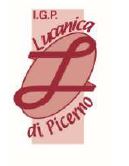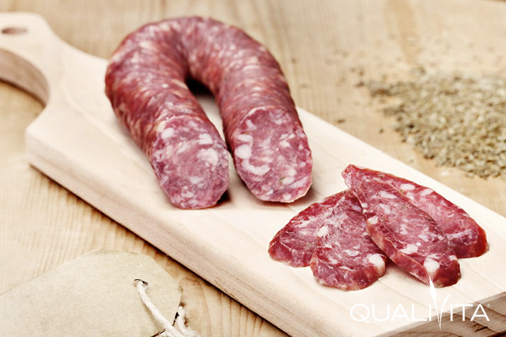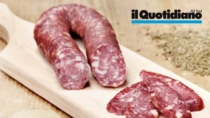Description
Lucanica di Picerno PGI is a charcuterie product obtained from a mixture of minced fresh meat from heavy pigs, aromatised and stuffed in natural pig casings. A Piccante (spicy) variation may also be produced.
Production Area
The production area of Lucanica di Picerno PGI is within the territory of the municipalities of Picerno, Tito, Satriano di Lucania, Savoia di Lucania, Vietri di Potenza, Sant’Angelo Le Fratte, Brienza, Balvano, Ruoti, Baragiano, Bella, Muro Lucano, Castelgrande and Sasso di Castalda, in the Province of Potenza, in the Basilicata region.
Production Method
Only the following pork cuts may be used to produce the ground meat: shoulder (boned and with nerves removed), neck, chuck, belly, tip of tenderloin and minced ham. The cuts are trimmed according to the traditional method, eliminating the soft fat tissue and connective tissue, and are then ground in special meat grinders for the production of medium-coarse grain mince. After grinding, salt, sweet or spicy chillis, wild fennel seeds, black pepper, dextrose and sucrose are mixed into the ground meat. The mixture is then left to stand for 4 to 24 hours at a maximum temperature of 8 °C, promoting the complete absorption of all the ingredients, after which it is stuffed into a natural casing. The drying process takes place in two stages to promote the natural dehydration of the product: the first stage involves the product being left to drip for 5 hours with a relative humidity of 90% and a maximum temperature of 22 °C; in the second stage the product is left to dry for 3 to 7 days. Finally, the product is cured for at least 18 days, in rooms with a temperature between 13 °C and 18 °C and a relative humidity between 75 and 85%.
Appearance and Flavour
Lucanica di Picerno PGI has a characteristic “U” shape, a diameter of 3 to 6 cm and a length of 20 to 35 cm, and can weigh anything from 250 to 350 g. The product destined to be sliced can weigh up to 1.2 kg, with a diameter of 3 to 3.6 cm and a length of between 40 and 70 cm. When cut, the slice is ruby red, tender and firm, with well-distributed flecks of fat. Its flavour comes from the predominant aroma of wild fennel, combined with the spicy aroma of pepper and the fragrance of peppers. The fragrance of peppers is stronger in the Piccante version.
History
The earliest sources testifying to the origins of Luganega's deep roots in the production area date back to Roman times, between the end of the 3rd and beginning of the 2nd century BC, as evidenced by historical sources such as Marcus Terentius Varro, Martial, Apicius and Cicero, who referred to the sausage they had discovered in Lucania. The lyrics of popular songs are further evidence of the evolution of the recipe for the sausage whose name, also known outside Italy, refers to the Roman Lucania. The first important initiatives in the production of charcuterie products outside the family environment started in the 1970s, valorizing the name and origin of the product in an organized manner.
Gastronomy
Lucanica di Picerno PGI should be kept in cool, dry environments. It is typically stored in terracotta containers, immersed in liquid lard. It is used as an ingredient in many traditional Lucanian recipes, and can be served as a starter, with other local charcuterie products and cheeses, or used as a main ingredient in pasta sauces or second courses, perhaps together with legumes and vegetables.
Marketing
The product is marketed as Lucanica di Picerno PGI and Lucanica di Picerno PGI Piccante. It is sold with or without packaging: vacuum-packed or in a protective atmosphere, whole, in pieces, or sliced.
Distinctive Features
The sensory specificity of Lucanica di Picerno PGI is the prevalence of the aroma of wild fennel, a plant that has grown abundantly in the area for centuries, thanks to the climate in the Lucanian Apennines, characterised by hot summers followed by months of heavy rainfall and snowy winters.










